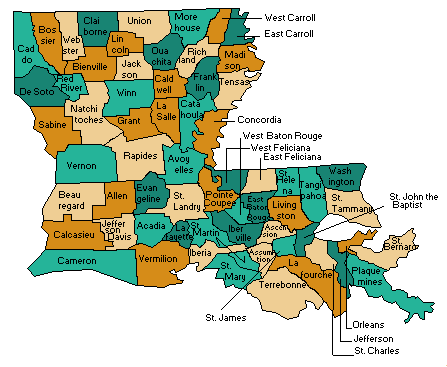The
STEVENS FamilyLouisiana History and Facts


Some Flat Facts
Located in the southeastern United
States, Louisiana lies entirely within the Gulf Coastal Plain. It is shaped like a capital
L, approximately 530 km (330 mi) at its widest, and about 450 km (280 mi) from north to
south. Louisiana is bordered by Mississippi on the east, the Gulf of Mexico on the south,
Texas on the west, and Arkansas on the north. Sighted by the Spanish in 1519, Louisiana
was first explored by Panfilo de NARVAEZ of Spain, who navigated its coast in 1528. Later,
Robert Cavelier, sieur de LA SALLE, named the region Louisiana in honor of the French king
Louis XIV, claiming it for France in 1682. The state's long and varied history, diverse
population, abundant energy resources, and strategic location at the mouth of the
Mississippi River are valued attributes. The problems that exist in Louisiana stem from
its prolonged recovery after the Civil War, its relatively slow industrial growth, and its
heavy dependence on extractive industries.
PEOPLE. Population (1990 census): 4,238,216; rank: 21st; density: 36.3 persons per sq km
(93.9 per sq mi). Distribution (1988 est.): 69.2% metropolitan, 30.8% nonmetropolitan.
Population increase (1980-90): 0.8%.
STATE SYMBOLS. Statehood: Apr. 30, 1812; the 18th state. Nickname: Pelican State; bird:
pelican (Eastern brown pelican); flower: magnolia; tree: bald cypress; motto: Union,
Justice, Confidence; songs: "Give Me Louisiana" and "You
Are My Sunshine."

LAND. Area: 123,677 sq km (47,752 sq
mi); rank: 31st. Capital: Baton Rouge. Largest city: New Orleans (1990 census, 496,938).
County equivalents (parishes): 64. Elevations: highest--163 m (535 ft), at Driskill
Mountain; lowest--minus 2 m (minus 5 ft), at New Orleans.
The population of Louisiana (1990 census) is 4,238,216. The state's population increased
15.4% from 1970 to 1980, but from 1980 to 1990 it increased only 0.8%. Louisiana has
become increasingly urban, with ten cities with populations of more than 50,000. The
largest are NEW ORLEANS, BATON ROUGE, SHREVEPORT, and Metairie. During the period 1970-85,
Louisiana experienced a net total in-migration of 129,000. A relatively small number of
persons are foreign-born; most of these live in New Orleans.
People of Louisiana
There is a rich diversity of peoples
in Louisiana (See Ancestry under Louisiana Demographics). They include the original Indian
inhabitants, plus the descendants of a variety of settlers, among whom were the French,
Spanish, English, German, Acadians, West Indians, Africans, Irish and Italians and now
include almost every nationality on earth.
The original French colonists were soon joined by the Spanish and Acadians, and later by
French aristocrats fleeing slave revolts in the West Indies or the horrors of the French
Revolution. As part of Louisiana's French legacy counties are called "parishes"
and the Napoleonic Code (rather than Common Law) holds sway in the state's courtrooms.
Some Odd Facts
Ironically, it was the Spanish who
built many of the colonial structures that still stand in the "French Quarter"
of New Orleans, and Spanish is still spoken in some communities, particularly in St.
Bernard Parish below New Orleans. Hundreds of German families were recruited in 1719 by
the Company of the West (which held the French royal charter for the development of
Louisiana), and those sturdy pioneers settled upriver from New Orleans along a section of
the Mississippi River that is still called the Cote des Allemands ("German
Coast"). The parishes north of Lake Pontchartrain (the sixth largest lake in the
U.S.) and east of the Mississippi River were once a part of British West Florida, occupied
by English planters and military in the 1700s. Bernardo de Galvez, Louisiana's Spanish
governor and an American ally in the Revolution, prevented the further development of a
British stronghold in the Mississippi Valley by capturing British forts at Manchac and
Baton Rouge in 1779.
Some years later, in 1810, citizens of the "Florida Parishes" staged the West
Florida Rebellion against Spanish authority in the region. They established the West
Florida Republic, which enjoyed independence briefly before joining the American territory
that had been acquired from France through the Louisiana Purchase of 1803.
Among the other nationalities that have settled in Louisiana are the Yugoslavians who made
a success of oyster harvesting along the Gulf Coast and the Hungarians who became
cultivators of strawberries and other crops in the Albany area. Free blacks amassed some
of Louisiana's largest land holdings prior to the Civil War and blacks have major
contributions to Jazz and Louisiana cuisine in particular. And many of Louisiana's annual
festivals are celebrations of particular ethnic contributions to the "cultural
gumbo" of this unique state.
Louisiana Resource Links
Yahoo Search for "Louisiana"
Links to Louisiana Resources
Louisiana Room Resources - LSU
Louisiana Materials - LSU Libraries
Louisiana State Library Server
See Also These Links
Area and Climate
Population
Vital Statistics and Health
Social Insurance and Welfare Services
Education
Public Finance, Government,
Politics and Elections
Law Enforcement, Courts and Prisons
Business Enterprises
Income, Employment and Labor
Agriculture, Forestry and Fisheries
Mining and Mineral Products
Housing and Construction
Manufacturing
Transportation, Communications
and Public
Utilities
Retail and Wholesale Trade
Finance, Insurance and Real Estate
Services
Tourism
